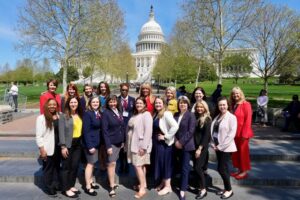WASHINGTON — A new report by the Governors Highway Safety Association (GHSA) highlights excessive vehicle speed as a persistent factor in nearly one-third of all motor vehicle-related fatalities.
Despite this, speeding is not given enough attention as a traffic safety issue and is widely deemed culturally acceptable by the motoring public, the report said.
“Speeding Away from Zero: Rethinking a Forgotten Traffic Safety Challenge” takes a fresh look at this challenging topic, outlining the latest available data and research, federal and state policies, existing programs to reduce speeding-related crashes, and promising future approaches, according to GHSA Executive Director Jonathan Adkins.
“If we want to get to zero deaths on our roads, we need to address speeding on a much deeper and more comprehensive level than we have been,” Adkins said. “This clear and present danger on our roadways makes it imperative to devote additional resources toward getting drivers to slow down in order to save lives.”
Speeding by motorists particularly threatens the safety of pedestrians and bicyclists by not only increasing the chances of a crash, but also increasing the risk of serious injury or death when crashes occur, the report said.
A 2017 national survey of drivers conducted by AAA Foundation for Traffic Safety found that half of motorists (50.3 percent) reported exceeding the speed limit by 15 mph on a freeway and 47.6 percent reported driving 10 mph over the speed limit on a residential street in the past month. In addition, this study found that there is a greater disapproval by drivers for speeding on a residential street than on freeways.
Of those respondents, 79.3 percent feel that speeding on freeways is a serious or somewhat serious threat to their safety, and 88.2 percent view drivers speeding on residential streets as a very serious or somewhat serious threat to their personal safety. However, 23.9 percent of respondents believed that speeding 15 mph above the posted speed limit on the freeway is “completely” or “somewhat” acceptable.
These self-reported behaviors and attitudes have varied only slightly in the previous 10 years, the report said.
On the other hand, even small decreases in travel speed can reduce crash and injury severity and save lives.
While some urban areas have had success in reducing vehicle speeds (for example, by lowering the speed limits in New York City and Boston), a greater proportion of speeding-related fatalities actually occur on rural roadways, claiming more than 5,000 lives in 2016 alone.
Vision Zero efforts have been at the forefront of steps to curb speeding in cities, and GHSA hopes to see this concept and its principles spread to more suburban and rural jurisdictions across the country.
Vision Zero is a strategy to eliminate all traffic fatalities and severe injuries, while increasing safe, healthy, equitable mobility for all. First implemented in Sweden in the 1990s, Vision Zero has proved successful across Europe — and now it’s gaining momentum in major American cities.
The GHSA report outlines of number of additional recommendations to reduce speeding on the nation’s roadways.
Suggestions consist of federal legislative and programmatic prioritization, more aggressive and sustained law enforcement efforts (including automated speed enforcement) and engineering the built environment for safer speeds through roundabouts and other traffic calming elements.
GHSA’s State Highway Safety Office members are uniquely positioned within state government to launch new speeding reduction programs, spearhead public education and enforcement efforts, and coordinate broad stakeholder alliances, the report said.
To confront the issue of speeding directly, GHSA, in partnership with the Insurance Institute for Highway Safety (IIHS), is convening a speeding forum in April, bringing together a wide range of stakeholders to develop the architecture of a new, integrated speed management program that state highway safety agencies and their many partners can implement in tandem to convince motorists, improve roadways, and change culture to prioritize safety over speed.
The Governors Highway Safety Association is a nonprofit association representing the highway safety offices of states, territories, the District of Columbia and Puerto Rico. It provides leadership and representation for the states and territories to improve traffic safety, influence national policy, enhance program management and promote best practices. Its members are appointed by their governors to administer federal and state highway safety funds and implement state highway safety plans.
For more information, visit www.ghsa.org.
The Trucker News Staff produces engaging content for not only TheTrucker.com, but also The Trucker Newspaper, which has been serving the trucking industry for more than 30 years. With a focus on drivers, the Trucker News Staff aims to provide relevant, objective content pertaining to the trucking segment of the transportation industry. The Trucker News Staff is based in Little Rock, Arkansas.








